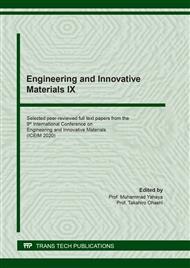[1]
J.A. Figueiredo, M.I. Ismael, C.M.S. Anjo, and A. P. Duarte, Cellulose and Derivatives from Wood and Fibers as Renewable Sources of Raw-Materials,, in Carbohydrates in Sustainable Development I, Y. Q. Rauter, Amélia P., Pierre Vogel, Ed. Springer, Berlin, Heidelberg, 2010, p.117–128.
DOI: 10.1007/128_2010_88
Google Scholar
[2]
M. Gama, F. Dourado, and S. Bielecki, Bacterial NanoCellulose From Biotechnology to Bio-Economy. (2016).
Google Scholar
[3]
A. F. S. Costa, F. C. G. Almeida, G. M. Vinhas, and L. A. Sarubbo, Production of bacterial cellulose by Gluconacetobacter hansenii using corn steep liquor as nutrient sources,, Front. Microbiol., vol. 8, no. OCT, p.1–12, (2017).
DOI: 10.3389/fmicb.2017.02027
Google Scholar
[4]
M. Dworkin, S. Falkow, E. Rosenberg, K.-H. Schleifer, and E. Stackebrandt, The Prokaryotes: A Handbook on the Biolog1. Dworkin M, Falkow S, Rosenberg E, Schleifer K-H, Stackebrandt E. The Prokaryotes: A Handbook on the Biology of Bacteria: Archaea. Bacteria: Firmicutes, Actinomycetes. The Prokaryotes: A Handbook on the Biology o. (2006).
DOI: 10.1007/0-387-30744-3
Google Scholar
[5]
K.H. Steinkraus, Fermentations in world food processing,, Compr. Rev. FOOD Sci. FOOD Saf., vol. 1, no. 1, p.1, (2002).
Google Scholar
[6]
R. Jonas and L. F. Farah, Production and application of microbial cellulose,, Polym. Degrad. Stab., vol. 59, no. 1–3, p.101–106, (1998).
Google Scholar
[7]
G. Guhados, W. Wan, and J. L. Hutter, Measurement of the elastic modulus of single bacterial cellulose fibers using atomic force microscopy,, Langmuir, vol. 21, no. 14, p.6642–6646, (2005).
DOI: 10.1021/la0504311
Google Scholar
[8]
K. Qiu and A. Netravali, In situ produced bacterial cellulose nanofiber-based hybrids for nanocomposites,, Fibers, vol. 5, no. 3, p.11–13, (2017).
DOI: 10.3390/fib5030031
Google Scholar
[9]
M. A. Naeem, Q. Siddiqui, M. Mushtaq, A. Farooq, Z. Pang, and Q. Wei, Insitu Self-Assembly of Bacterial Cellulose on Banana Fibers Extracted from Peels,, J. Nat. Fibers, vol. 00, no. 00, p.1–12, (2019).
DOI: 10.1080/15440478.2018.1563580
Google Scholar
[10]
K. Kulasinski, Effects of water adsorption in hydrophilic polymers,, Polym. Sci. Res. Adv. Pract. Appl. Educ. Asp., no. September, p.217–223, (2016).
Google Scholar
[11]
P. Navi and D. Sandberg, Thermo-hydro-mechanical Processing of Wood. Taylor & Francis Group, LLC, (2011).
Google Scholar
[12]
J. Song et al., Processing bulk natural wood into a high-performance structural material,, Nature, vol. 554, no. 7691, p.224–228, (2018).
Google Scholar
[13]
X. Han, Y. Ye, F. Lam, J. Pu, and F. Jiang, Hydrogen-bonding-induced assembly of aligned cellulose nanofibers into ultrastrong and tough bulk materials,, J. Mater. Chem. A, vol. 7, no. 47, p.27023–27031, (2019).
DOI: 10.1039/c9ta11118b
Google Scholar
[14]
V. Sacchetti et al., Effect of Charge-Assisted Hydrogen Bonds on Single-Molecule Electron Transport,, J. Phys. Chem. C, vol. 123, no. 48, p.29386–29393, (2019).
DOI: 10.1021/acs.jpcc.9b06850
Google Scholar
[15]
M. Iguchi;, S. Yamanaka;, and A. Budhiono;, Bacterial cellulose - a masterpiece of nature's arts,, J. Mater. Sci., vol. 35, no. 2, p.261–270, (2000).
Google Scholar
[16]
ASTM International, ASTM D 3039 - Standard Test Method for Tensile Properties of Polymer Matrix Composite Materials,, ASTM Book of Standards. p.99–109, (2010).
Google Scholar
[17]
A. Chami Khazraji and S. Robert, Self-assembly and intermolecular forces when cellulose and water interact using molecular modeling,, J. Nanomater., vol. 2013, (2013).
DOI: 10.1155/2013/745979
Google Scholar
[18]
J. Juntaro, M. Pommet, G. Kalinka, A. Mantalaris, M. S. P. Shaffer, and A. Bismarck, Creating hierarchical structures in renewable composites by attaching bacterial cellulose onto sisal fibers,, Adv. Mater., vol. 20, no. 16, p.3122–3126, (2008).
DOI: 10.1002/adma.200703176
Google Scholar
[19]
M. Pommet et al., Surface modification of natural fibers using bacteria: Depositing bacterial cellulose onto natural fibers to create hierarchical fiber reinforced nanocomposites,, Biomacromolecules, vol. 9, no. 6, p.1643–1651, (2008).
DOI: 10.1021/bm800169g
Google Scholar
[20]
C. Baley, Analysis of the flax fibres tensile behaviour and analysis of the tensile stiffness increase,, Compos. - Part A Appl. Sci. Manuf., vol. 33, no. 7, p.939–948, (2002).
DOI: 10.1016/s1359-835x(02)00040-4
Google Scholar
[21]
A. Boukir, S. Fellak, and P. Doumenq, Structural characterization of Argania spinosa Moroccan wooden artifacts during natural degradation progress using infrared spectroscopy (ATR-FTIR) and X-Ray diffraction (XRD),, Heliyon, vol. 5, no. 9, p. e02477, (2019).
DOI: 10.1016/j.heliyon.2019.e02477
Google Scholar
[22]
D. Tareste, F. Pincet, E. Perez, S. Rickling, C. Mioskowski, and L. Lebeau, Energy of hydrogen bonds probed by the adhesion of functionalized lipid layers,, Biophys. J., vol. 83, no. 6, p.3675–3681, (2002).
DOI: 10.1016/s0006-3495(02)75367-8
Google Scholar


